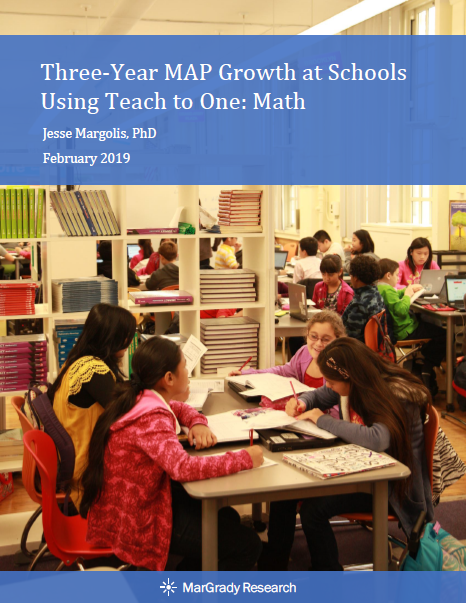Jesse Margolis
February 2019
Background
Teach to One: Math (TtO) is an innovative model of teaching mathematics that re-envisions the way in which teachers, students, and curriculum interact in middle and high school classrooms to provide a more personalized learning experience for every student. Through a technology-infused mix of direct instruction, collaborative work with peers, and individualized learning, TtO seeks to introduce students to mathematics content at the right level for them. This study compares three-year math test score growth on the NWEA’s MAP test at all 14 schools that used TtO from 2015-16 to 2017-18 to a national reference group, controlling for each student’s starting score. This study also begins to explore the relationship between the content students are presented with during the year and their subsequent test score gains.
Findings
This study finds evidence that TtO students at these 14 schools are, on average, improving on the MAP math test at a faster rate than a nationally representative comparison group.
Key Findings Include:
- From fall 2015 to spring 2018, scores on the math MAP test for consistently-enrolled TtO students improved sufficiently to raise the average school-level percentile by 20 points, corresponding to 23% more growth, on average, than a national reference group.
- A broader group of students – including those not consistently enrolled – showed average three-year gains of 13 school-level percentile points and 12% greater improvement in the average math MAP test score.
- A group of ‘MAP growth-aligned’ schools – those subject to external accountability systems that prioritize growth on the MAP test – showed average three-year gains among consistently-enrolled students of 38 school-level percentile points, which corresponds to 53% more growth.
- There is suggestive evidence that schools with a smaller content gap – those where the math content presented better matched students’ tested grade level from the beginning of the year – tended to see greater gains.
Figure – Average MAP Score and School-Level Percentile (Consistently-Enrolled Students)

The figure shows the average MAP score and school-level percentile for the 739 consistently-enrolled students in all 14 schools that participated in TtO between 2015-16 and 2017-18. As shown in the figure, the average MAP score increased from 210.4 in the fall of 2015-16, when these students were 6th graders, to 227.5 in the spring of 2017-18, when these students were 8th graders. This test score increase was consistent with a 20-point increase in the school-level percentile, from the 15th percentile in the fall of 6th grade to the 35th percentile in the spring of 8th grade, when compared to the national norms in NWEA’s 2015 MAP Norms Study. The gains shown in the figure are restricted to consistently-enrolled students to provide insight into growth among students who were exposed to the TtO program over three years. There were also gains, though somewhat smaller, when expanding the sample to include all students tested in any time period. As shown in the full report, the school-level percentile for all students tested – including transient students who were not consistently enrolled – increased by 13 points over three years, from 15 in the fall of 2015 to 28 in the spring of 2018.
Media Coverage
Chalkbeat (February 21, 2019) – This personalized learning program was supposed to boost math scores. It didn’t, new study finds
Education Week (February 21, 2019) – ‘Teach to One’ Personalized-Learning Model Has No Effect on Students’ Math Scores, Federal Evaluation Finds
The Hechinger Report (February 25, 2019) – New study casts doubts on effectiveness of personalized learning program in New Jersey
Forbes (March 5, 2019) – Why The Nation’s K-12 Accountability And Assessment System Doesn’t Make The Grade
Education Week (March 7, 2019) – Different Paths to the Same Goal: College and Career Readiness
The 74 (March 25, 2019) – Does Personalized Learning Work? The Research Is Too Scant, Too New and Too Nuanced to Give a Clear Yes or No – At Least for Now
